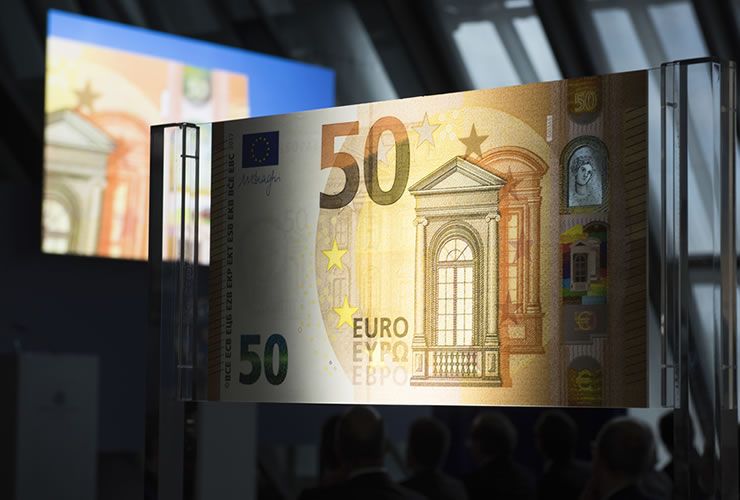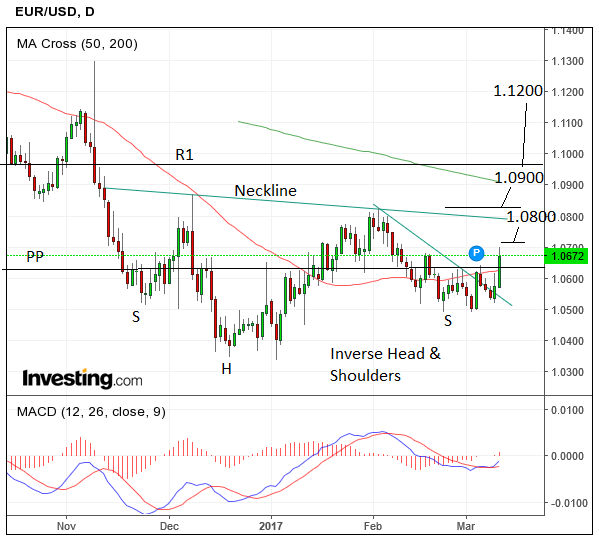5-Day Forecast for Euro / Dollar Exchange Rate

The Euro to Dollar exchange rate has broken above some key levels such as the 50-day moving average and the trendline for the move down from the February highs.
The strong up-day on Friday and the previous strong move up on the previous Monday had set the scene for a reversal, however, ideally we would like to see more upside still for confirmation.
A break above the 1.0712 highs would probably lead to an extension higher to the next target at the 1.0800 level.
If the pair has formed an inverse head & shoulders (iH&S)pattern at the lows as has been suggested by Société Générale (SocGen) in a recent note, this bodes very bullish for the pair.
If the iH&S breaks above its neckline, situated at the level of the intervening peaks between the troughs, it would confirm a continuation higher, potentially to 1.1200.
The iH&S is formed of three troughs in which the middle trough is the lowest and the two either side are roughly of a similar depth.
The middle trough is labelled the ‘Head’ and the two troughs either side ‘Shoulders’.
These patterns are often quite reliable at indicating a reversal of the trend from down to up.
The target for the upside breakout is the same distance (Y) as the height of the head (X).
SocGen think the neckline of the pattern, situated at around 1.0810 could be ‘tested’.
A break above 1.0825 would confirm a breakout higher, to a target at 1.0900 and the 200-day moving average initially.
A move above 1.0950 would confirm an extension to 1.1200 and the end target for the iH&S.

Longer-term, the outlook for the exchange rate is likely to be 'more of the same'.
"The currency markets remain in a random, two-way rotational environment with contracting volatility, which is a long-winded way of saying that there is no trend in the short-term. These markets continue to trade mostly sideways, as they have for much of the year to date. There was a reasonably large daily move in the EUR/USD on Friday, with a similar move in the opposite direction in the Dollar Index. The long-term trend remains in favour of the dollar," says analyst Phil Seaton at LS Trader.
EU Inflation, Dutch Elections form this Week's Highlight
Looking ahead to events that could ultimately shift the Euro this week, the main data release for the Euro in the week ahead will be inflation data for February, which is forecast to continue the recent up-trend, which saw a 1.8% rise in January and is forecast to show a 2.0% rise in February.
The Euro could be set to continue outperforming other counterparts in the week ahead due to a positive upgrading of inflation expectations by the ECB in its March statement, from 1.3% to 1.7% in 2017, and a positive general economic outlook as voiced by ECB president Draghi at the post-meeting press conference.
“This past week, the ECB left monetary policy unchanged and as President Mario Draghi spoke, the EUR/USD raced above 1.06. Nodding to the improvements in growth and inflation, the central bank raised its 2017 and 2018 GDP forecast by 0.1% and boosted this year’s inflation forecast to 1.7% from 1.3%,” says BK Asset Management’s Kathy Lien.
“Draghi admitted that economic risks are less pronounced and the ongoing economic expansion should be firm and continue to broaden. Draghi's less-dovish comments encouraged traders to take profits on short euro positions and while dollar and euro bulls will need to battle it out, the euro should outperform other currencies,” adds Lien.
The weight of political uncertainty may also ease on the Euro in the week ahead, following Dutch elections on March 15.
The anti-EU PVV party has seen its share of the vote fall in opinion polls recently, which showed a decline to 22% from 35%.
Assuming the results come in more or less in line with these polls the PVV are unlikely to have the mandate to form a government and exact change.
“Electoral risks finally start to be resolved and we see low risks here. Anti-EU PVV support has fallen, now suggesting a toss-up with VVD (current government’s senior party). Even as the largest party, it is unlikely they would join a coalition, and even then, a Nexit referendum is non-binding. Polls close 8pm GMT, with results dribbling out. Reaction should be muted post-Fed, with a sharper move lower on surprise PVV strength (@35 seats out of 150),” say TD Securities in a note seen by Pound Sterling Live.
With no party set to command more than 30 seats in the 150-seat parliament, at least four parties will be required to form a government.
Convention dictates that, were it to win the popular vote, Wilders’ Freedom Party would have first attempt at forming a government.
"However, most of the other main parties have ruled out co-operating with the Freedom Party and there is no rule that the government must contain the largest party," says Peter Schaffrik at RBC Capital Markets.
In order to deliver its commitment to withdraw the Netherlands from the EU, the Freedom Party would: 1) need to form a government that would agree to put a referendum bill to parliament; and 2) gain parliamentary approval, "neither of which appear likely possibilities," says Schaffrik.
US Fed Dominates Week Ahead for US Dollar
Dominating the week ahead is the Federal Reserve Open Market Committee meeting on Wednesday, March 15 at 18.00 GMT, and a press conference with Janet Yellen, the Fed Chair afterwards.
There is now a 100% - or close to – estimated chance the FOMC will decide to increase US interest rates by 0.25% to 1.00%.
Since this is now beyond doubt, traders will instead be focusing in what Janet Yellen says in her Press Conference about the possibilities of a June rate rise as this will be the next big question for markets.
The overall expectations for future policy from all FOMC voting members will also be illustrated by the Fed’s dot plot chart in the Fed's economic projections document that will be released.
The dot plot chart indicates expectations amongst Fed members for future interest rate moves - if the dots are lifted then this would be seen as positive for the Dollar.
Investors will be paying a close attention to this as a possible indicator of appetite for June hike, as well as whether the Fed now expect to hike rates more than 3 times in 2017.
Wednesday is also a key day for the Dollar on the hard data front as it will witness the release of February Inflation data.
Core CPI is forecast to rise by 2.2% from the previous year.
Headline CPI is expected to come out at 0.1% from 0.6% in the previous month of January and Core CPI, on a monthly basis, is expected to show a 0.2% rise.
The CPI data is released at 12.30, prior to the FOMC, and whilst no surprises are foreseen, a downside shock is one of the last remaining risks to the FOMC not raising rates, however, it would have to be a deep plunge to impact and that is highly improbable.
Core Retail Sales, which means without volatile fuel and food sales, is also released on Wednesday at 12.30, and is expected to rise by 0.2% in February from a higher 0.6% in January.
Thursday March 16 sees the release of Housing data, starting with Building Permits at 12.30, which are forecast to fall to 1.26m from 1.29m in February.
Housing Starts, out at the same time, are expected to grow to 1.26m from 1.248m previously.
Commentators are waiting for signs from the housing market that rising interest rates are starting to reign in mortgage borrowing and slow the housing market down, but so far this has not yet happened.
A slow-down in housing would be a negative indicator for the economy as it is a widely held market maxim that the economy “follows Housing”.










